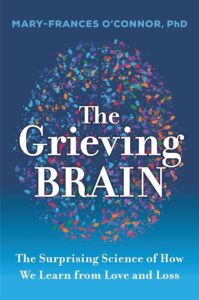If you are enrolled on one of our training courses, log in here to access all the course resources.
We add to our library of open-access resources regularly, so please check this page regularly, or subscribe to get updates delivered to your inbox.

The Grieving Brain
It’s hard – almost impossible – to wrap our minds around the concept of someone being gone forever. This can be one of the most painful and haunting parts of the grieving process. Waking up each morning, having to reacquaint yourself again with the knowledge your loved one is gone. Thinking you spot them in a crowd, or hear their voice, only to realise their death all over again. This can go on for a long time.
In The Grieving Brain, renowned grief expert and neuroscientist Mary-Frances O’Connor, PhD, explains the neuroscience behind grieving. Our brains are rich with neural connections and pathways, which help us navigate our world more quickly and without conscious thought a lot of the time. Think of the last time you drove home from work, with a project or conversation very much on your mind. You pull up outside your house, and have no recollection of the journey. Your brain’s neural pathways took over the navigating, leaving you free to argue, plan, or do whatever else was filling your conscious mind as you drove. You were on automatic pilot.
We have neural pathways for everything that is familiar, known, experienced, loved. When somebody important to us dies, it takes a long, long time for the brain to rewire, and create new neural connections that mirror the now-version of our world, replacing the-then version. And while this process takes place, we’re struggling to come to terms with the sense of loss, and this new reality that we’re faced with.
This book is essential reading for anyone wanting to understand the experience of grief better. Mary-Frances O’Connor has long been a pioneer in the field of grief research, and is a leading expert in the field of prolonged grief. Her TedX talk on how our brains process grief is a must-see video.
Loss and Restoration
The Dual Process model was a ground-breaking model when it was published by in 1999. Unlike the famous Kubler-Ross model, the Dual Process model is based on the recognition that the grieving process is not linear, not a straightforward progression as though grief was something to recover from. Grieving involves fluctuation, between focusing on the loss and starting to rebuild your life.
When we are supporting grieving people, we need to support them through more than just the visible signs of mourning. They need understanding and support from us, not just when they are weeping, but when they are endeavouring to rebuild their life too. We might see this work as wholly positive, and assume that it means they are coping well, and ‘getting over it’. But their experience of the restoration process could be as difficult to navigate as their experience of the loss. This video explains the Dual Process model and how it helps us understand all aspects of the grieving and rebuilding process.
Words Matter
Evie’s dad died by suicide. This fantastic video was made by her in collaboration with Alive With Ideas, and illustrates how important our words are.
How Do You Help A Grieving Friend?
“It’s hard to know what to do when someone is going though a difficult time. The thing is, you can’t cheer someone up by telling them to look on the bright side, or by giving them advice. It just doesn’t work. Watch this video to learn the one thing that will help you support your friends in the most helpful and effective ways.”
Video & Content Copyright: Megan Devine and Refuge in Grief.
We also recommend Megan Devine’s wonderful book:
It’s OK That You’re Not OK: Meeting Grief & Loss in a Culture That Doesn’t Understand
You don’t move on
“When Someone You Love Dies, There Is No Such Thing As Moving On”
Watch this insightful TedX talk from Kelley Lynn at TEDxAdelphiUniversity

Bereaved by Suicide
Download the Grief To Hope Report here
“My experience of suicide is that it is the equivalent of a bomb going off in your living room while you’re sitting watching telly. Afterwards you’re astonished you’re alive, but everything has changed and you have a million shards of glass embedded in your soul. Some of them are so big they fall out straight away leaving gaping wounds. But the little pieces, they can take decades to work their way up to the surface.” [1]
Any bereavement is difficult, but losing someone to suicide adds another level of pain. It has been described as grief with the volume turned up. When someone takes their own life, the shock and horror of that can have an ongoing ripple effect on those left behind.
This powerful report gives a voice to the many who face bereavement by suicide each year. It talks about the effects of losing someone to suicide, the challenges facing those left behind, and what kind of support they most need.
1.McDonnell S, Hunt IM, Flynn S, Smith S, McGale B, Shaw J. From Grief to Hope: The Collective Voice of those Bereaved or Affected by Suicide in the UK. Manchester: University of Manchester. November 2020
Myths About Suicide
Myths features real people, telling real stories of lived and living experience of suicide and suicide bereavement. Created by film agency, Brother, in collaboration between PAPYRUS Prevention of Young Suicide, Survivors of Bereavement by Suicide (SoBS) and Rethink Mental Illness.
